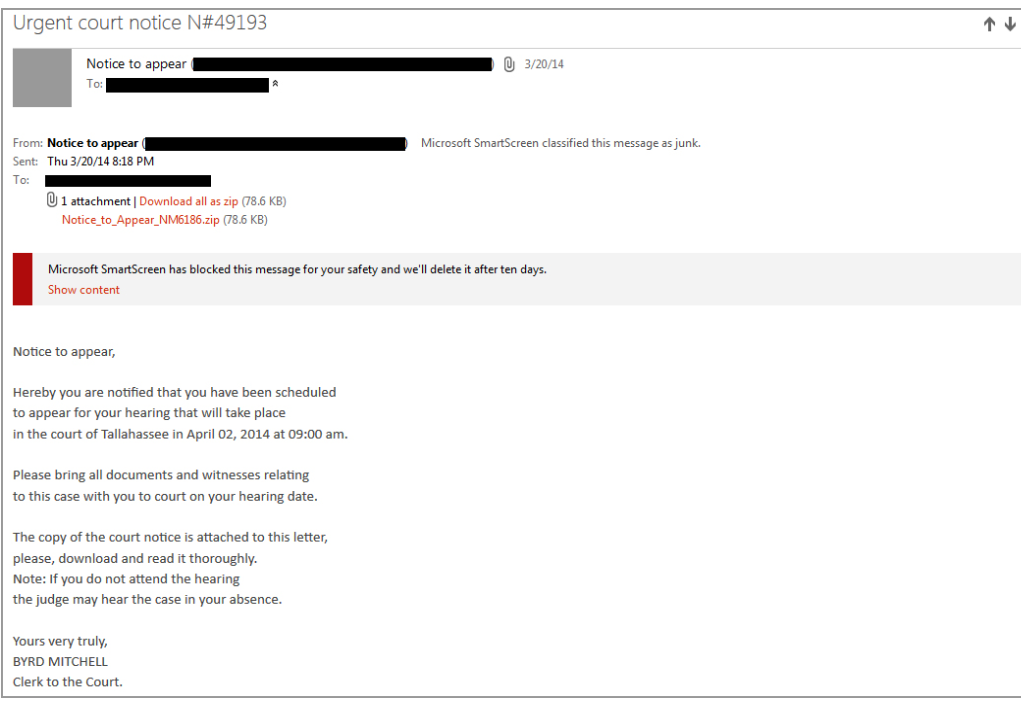Supreme Court Email Scam
What is Supreme Court Email Scam
Supreme Court Email Scam refers to a scam email that claims to be from UK’s Supreme Court. There a couple of slightly different scam emails that claim to come from the same institution, either carrying an attachment or containing a link. The one with an attached file is carrying the AsyncRAT remote access trojan that can initiate when the file is opened. Clicking a link would lead users to a website that could trick them into downloading and opening a malicious file.

Cyber criminals have long since used known companies and legitimate goverment institutions to trick users into opening malicious attachments and clicking on links, and this is no different. The attempt is fairly obvious but regardless, less attentive users may not think twice about opening it. They often contain spelling and grammar mistakes that would not be present in official emails sent by said institutions, address the receiver using generic “Sir/Madam”, “Member”, “Customer”, etc., instead of using names, and pressure users into opening the email attachments/clicking on links.
If you have recently received an email from the Supreme Court and opened the attached file or clicked on a link, we strongly suggest you scan your computer with anti-malware software. A lot of malware infections may be unnoticed to users without some kind of security tool because they do not show any outright signs of being present while carrying out malicious activities in the background.
Depending on the email, you may be asked to open a file attachment or click on a link, neither of which you should do. If you do download and open the file attached to the Supreme Court Email Scam, you would download the AsyncRAT trojan. It’s essentially a remote access tool that could control a computer remotely. Using it, cyber crooks could access computer files, personal documents, open websites, steal information, etc. Because of its features, it’s a dangerous infection, which you would need to get rid of right away.
If you receive this kind of email in the future, you can safely remove Supreme Court Email Scam from your inbox. Do not engage with it and if possible, report it to relevant authorities. Furthermore, to prevent a potential infection in the future, you should familiarize yourself with how spam emails carrying infections look like.
How to differentiate legitimate and scam emails
As we’ve said above, the majority of scam emails will be quite obvious. This particular Supreme Court Email Scam declares that you need to review a case document attached to the email because there has been a new filing. It also gives a deadline for a response. An email talking about such a serious matter would be very official but this scam version is quite casual, despite not having obvious spelling mistakes which are so common in such emails. It also uses a generic “Hello” or “Good day” to address the receiver. If a company or organization were to contact you on such an official matter, you would be addressed by name, not something generic.
You also keep in mind that very often, scammers use names of real employees to introduce themselves. For example, the sender of one of the Supreme Court scam emails introduces themselves as Richard Heaton, the current Permanent Secretary. If users were to research him, they would find that he is indeed a real person. This is a tactic used by scammers to make users lower the guard and be more trusting. So even if who the sender claims to be is a real person, that does not mean they sent the email.
Whenever you receive an unsolicited email, you should check the sender’s email address. Very often, spam emails are sent from email addresses that are made up of random letters and numbers. No official or professional email will ever be sent from such random addresses. Even if the email does look like it could belong to the person/company the sender claims to be from, you should always research it to make sure.
Finally, we strongly recommend scanning all unsolicited email attachments with anti-malware software or a service like Virus Total before you open them.
Supreme Court Email Scam removal
If one such email lands in your inbox, you can safely delete Supreme Court Email Scam from your inbox. Do not open the attachment or click on the link. If you have opened an attached file or downloaded something, you should scan your computer with anti-malware software immediately. These kinds of emails can carry serious infections so do not wait to perform a scan.
Site Disclaimer
WiperSoft.com is not sponsored, affiliated, linked to or owned by malware developers or distributors that are referred to in this article. The article does NOT endorse or promote malicious programs. The intention behind it is to present useful information that will help users to detect and eliminate malware from their computer by using WiperSoft and/or the manual removal guide.
The article should only be used for educational purposes. If you follow the instructions provided in the article, you agree to be bound by this disclaimer. We do not guarantee that the article will aid you in completely removing the malware from your PC. Malicious programs are constantly developing, which is why it is not always easy or possible to clean the computer by using only the manual removal guide.
